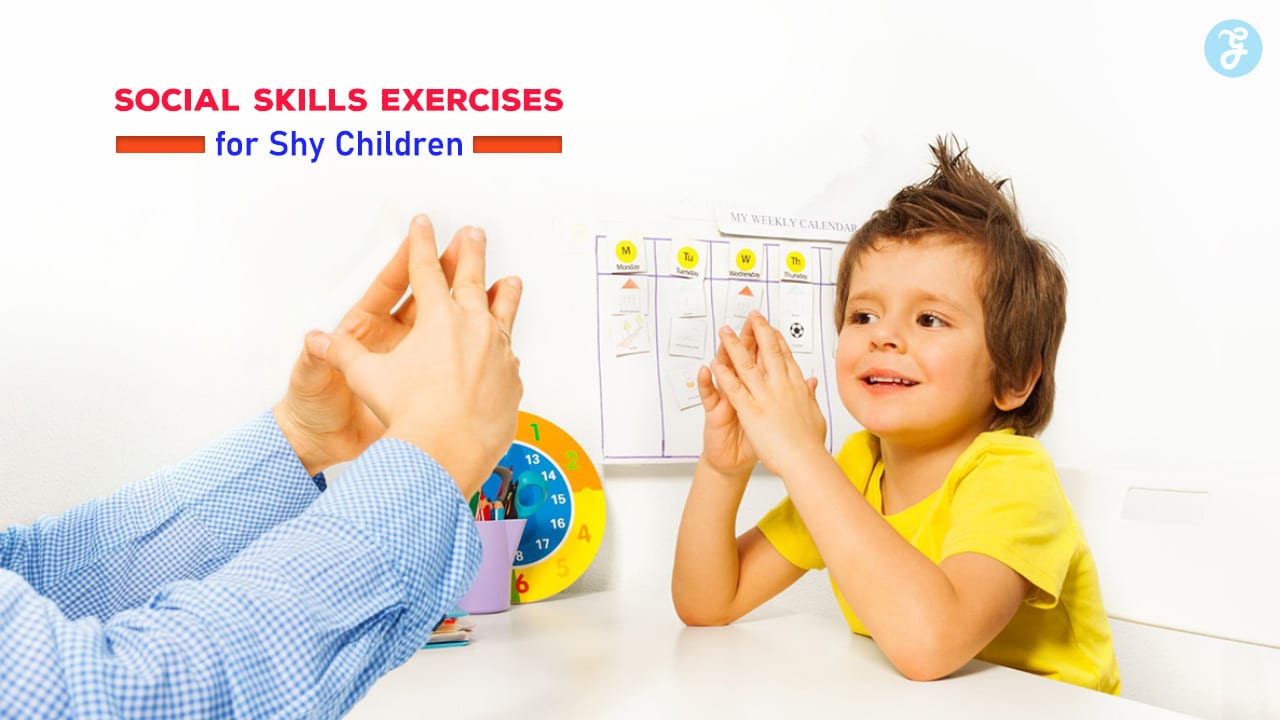Shyness in children is a common personality trait, but it can sometimes hinder their ability to interact with peers, express themselves, or build relationships.
While shyness isn’t inherently negative, helping children develop social skills can enhance their confidence and enable them to thrive in social settings. Social skills are learned behaviors that children can practice and improve over time.
Whether your child feels anxious in large groups or struggles to make friends, there are targeted exercises that can help them feel more comfortable in social environments.
This guide offers eight carefully designed social skills exercises that will not only support shy children but also help them improve communication, build friendships, and feel more confident.
These exercises are rooted in understanding, patience, and gentle encouragement, providing children with the tools they need to succeed socially.
Why Social Skills Are Important for Shy Children
Social skills are crucial for navigating everyday interactions, making friends, and expressing emotions in healthy ways. For shy children, the world can feel overwhelming, particularly in new or unfamiliar social situations.
Without proper guidance, they may retreat inward, avoiding interactions that could foster personal growth and meaningful relationships.
By engaging in social skills exercises, shy children can learn how to initiate conversations, handle group dynamics, and express their needs without feeling overwhelmed.
These exercises are designed to build confidence and resilience over time, allowing children to participate more fully in school, playgroups, and other social environments.
1. Role-Playing Scenarios
Role-playing is an incredibly effective exercise for helping shy children practice real-life social interactions in a safe, controlled environment.
By engaging in role-playing scenarios, children can rehearse how to navigate conversations, ask questions, and respond to others without the pressure of an actual social situation.
For example, you could create a scenario where your child is meeting a new friend at school. You can take turns playing different roles, such as the new friend, the teacher, or another student, and guide your child through potential conversations.
This helps them develop strategies for introducing themselves, asking about others, and responding to questions. The more your child practices these scenarios, the more confident they’ll feel when they encounter similar situations in real life.
How to Set Up Role-Playing Exercises at Home
To get started with role-playing, choose simple, everyday situations that your child may encounter, such as asking someone to play at recess or saying hello to a new classmate.
Use props or costumes to make the experience more engaging, and encourage your child to switch roles so they can experience different perspectives. Be sure to provide positive feedback and guidance throughout the exercise, gently correcting any awkward moments while reinforcing their efforts.
Role-playing helps shy children gain the confidence to tackle social situations with greater ease, preparing them for real-world interactions.
2. Building Empathy Through Storytelling
Empathy is a key social skill that allows children to understand and relate to the emotions of others. For shy children, developing empathy can make social interactions less intimidating by helping them realize that others experience similar feelings of nervousness or discomfort. One effective way to build empathy is through storytelling.
By reading stories that focus on characters facing challenges in social situations, children can learn to put themselves in others’ shoes and consider different perspectives. For instance, you might choose a story about a child who is feeling left out or nervous about making new friends.
After reading, engage your child in a discussion about the characters’ emotions and ask how they would feel in a similar situation. This not only builds empathy but also encourages shy children to express their own feelings more openly.
Encouraging Children to Tell Their Own Stories
Another way to build empathy through storytelling is by encouraging your child to create their own stories. Ask them to write or verbally share a story about a time when they felt shy, scared, or unsure in a social setting.
This allows them to reflect on their experiences, and you can offer guidance on how they might handle similar situations in the future. Storytelling fosters both empathy and self-expression, giving shy children the tools to better understand and navigate social dynamics.
3. Practice Active Listening
Active listening is an essential social skill that enables children to engage more deeply in conversations and show empathy towards others. For shy children, learning how to be a good listener can help them feel more comfortable in social situations because it shifts the focus from speaking to understanding.
Additionally, when children learn to listen actively, they feel more connected to their peers, which can help build lasting friendships.
Active listening involves making eye contact, nodding or using small verbal cues to show you’re paying attention, and responding thoughtfully to what the other person is saying. Teaching your child these skills will help them feel more confident in conversations, even if they’re not leading the discussion.
Exercises to Develop Active Listening Skills
One simple exercise to practice active listening is to have your child listen to a short story or conversation and then ask them to summarize what they heard.
You can also engage in a “listening circle” game, where family members take turns speaking while others listen closely and repeat back what was said. This exercise helps children focus on what others are saying rather than feeling anxious about what they’ll say next.
By practicing active listening, shy children can develop better communication skills, making them feel more at ease in group settings or one-on-one conversations.
4. Small Group Activities
Small group activities offer an ideal environment for shy children to practice social interactions without feeling overwhelmed. Unlike large gatherings, where shy children may feel lost or anxious, small groups provide a more intimate and manageable setting for them to engage with others.
These activities also offer opportunities to practice turn-taking, sharing, and cooperating with peers—all important social skills.
Small group activities can include board games, art projects, or building something together with Legos. The key is to choose activities that encourage collaboration and communication without putting too much pressure on individual performance. Over time, children will gain confidence in their ability to participate in group dynamics.
Tailoring Group Activities to Your Child’s Interests
To make group activities more appealing, tailor them to your child’s interests. If your child loves drawing, invite a couple of friends over for a collaborative art session.
If they enjoy building, set up a Lego challenge where each child contributes to a shared structure. By focusing on activities your child enjoys, they’ll feel more motivated to participate, which can help reduce social anxiety and improve their ability to interact with others.
Small group activities create a supportive environment where shy children can build social skills at their own pace with gentle encouragement and guidance from adults.
5. Encourage Playdates
Playdates offer an excellent opportunity for shy children to practice social skills in a relaxed, one-on-one setting. Unlike larger group interactions, playdates allow children to form deeper connections with one peer at a time, which can help build their confidence in social situations.
These interactions often feel less overwhelming and allow shy children to practice conversation, sharing, and cooperation in a more controlled environment.
Arranging regular playdates with familiar friends can help your child become more comfortable in social settings over time. It’s important to choose a child that your child feels at ease with, as this will make the experience more enjoyable and less stressful.
How to Plan Successful Playdates for Shy Children
When planning playdates, create a comfortable environment by setting up activities that both children enjoy. Whether it’s a craft project, a board game, or simply playing with toys, having a structured activity can help ease the pressure of conversation.
Additionally, try to keep the playdate relatively short at first, around an hour or two, to avoid overwhelming your child. As your child becomes more confident, you can gradually extend the length of the playdate.
Playdates allow shy children to practice social skills in a low-pressure setting, helping them build the confidence needed to navigate larger social environments.
6. Non-verbal communication Games
Social interactions aren’t just about words—non-verbal cues like body language, facial expressions, and gestures play a huge role in communication.
For shy children, focusing on non-verbal communication can be a helpful way to engage socially without the pressure of speaking. Learning to interpret and use non-verbal signals can make interactions less intimidating and help children express themselves more effectively.
Non-verbal communication games are a fun way to teach these skills. Games like charades, where children act out words or phrases without speaking, encourage them to use gestures and body language to communicate.
These activities can help shy children realize that communication doesn’t always have to involve talking, making social interactions feel less daunting.
Strengthening Social Awareness with Body Language Games
Another exercise involves having children watch a short video clip of people interacting without sound. Ask them to guess what the people in the video might be feeling or thinking based on their body language and facial expressions. This helps children become more aware of the non-verbal cues people use in everyday interactions and allows them to practice interpreting social signals.
By focusing on non-verbal communication, shy children can learn to engage with others in ways that feel comfortable, while also developing a deeper understanding of how people communicate beyond words.
7. Building Confidence with Praise and Reinforcement
Building confidence is essential for helping shy children develop stronger social skills. One of the most effective ways to boost a child’s self-esteem is through praise and positive reinforcement.
When children receive encouragement and recognition for their efforts in social situations, they are more likely to feel confident and motivated to continue improving.
However, it’s important to praise specific behaviors rather than offering general compliments. For example, instead of saying, “Good job,” try saying, “I noticed how you asked your friend to play with you—that was really brave!” This type of targeted praise helps children understand what they’re doing well and encourages them to repeat those behaviors in the future.
Creating a Reward System for Social Progress
In addition to verbal praise, you can create a simple reward system to encourage your child’s social growth. For example, each time they initiate a conversation, share with a friend, or participate in a group activity, they can earn a sticker or token.
Once they’ve earned a certain number of stickers, they can trade them in for a small reward, such as extra playtime or a favorite treat. This system provides positive reinforcement and motivates shy children to continue practicing their social skills.
With consistent praise and reinforcement, shy children will begin to see themselves as capable and confident, which can significantly improve their social interactions.
8. Joining Clubs or Social Groups
For shy children, joining clubs or social groups can be an excellent way to meet new friends and practice social skills in a structured environment.
Clubs based on shared interests, such as art, music, sports, or science, provide a natural way for children to interact with others without the pressure of unstructured socializing. These environments encourage teamwork, cooperation, and communication, all of which are crucial for developing social skills.
When children join a group where they can pursue an activity they enjoy, they’re more likely to feel comfortable and engage with others who share their interests. This can help them form friendships and gain confidence in their social abilities.
Choosing the Right Social Group for Your Child
When choosing a club or group for your child, consider their interests and comfort level. Some children may prefer smaller, more intimate groups, while others might feel ready for larger clubs. It’s also important to provide ongoing support by attending group meetings with your child at first or discussing their experiences after each session.
Joining clubs or social groups provides shy children with a consistent opportunity to practice social skills in a supportive and structured setting, helping them grow more confident in social situations.
Conclusion
Helping shy children develop social skills requires patience, understanding, and consistent support. By incorporating these eight exercises into your child’s routine, you can gradually help them build the confidence and communication skills they need to navigate social situations with ease.
Whether through role-playing, storytelling, or structured group activities, these exercises offer shy children a safe and supportive environment to practice and grow.
Remember, every child is different, and progress may take time. Encourage your child with positive reinforcement and create opportunities for them to engage in social interactions at their own pace.
With dedication and encouragement, even the shyest child can develop the social skills they need to succeed in school, make friends, and thrive in everyday life.








































